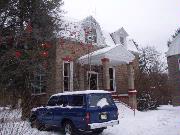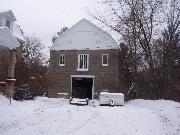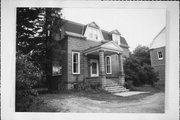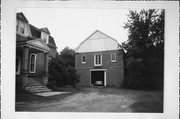Property Record
405 W PROSPECT ST
Architecture and History Inventory
| Historic Name: | Ed Kemp-Eugene Shepard House |
|---|---|
| Other Name: | |
| Contributing: | |
| Reference Number: | 81314 |
| Location (Address): | 405 W PROSPECT ST |
|---|---|
| County: | Oneida |
| City: | Rhinelander |
| Township/Village: | |
| Unincorporated Community: | |
| Town: | |
| Range: | |
| Direction: | |
| Section: | |
| Quarter Section: | |
| Quarter/Quarter Section: |
| Year Built: | 1920 |
|---|---|
| Additions: | |
| Survey Date: | 1995 |
| Historic Use: | house |
| Architectural Style: | Dutch Colonial Revival |
| Structural System: | Masonry |
| Wall Material: | Rock-Faced Concrete Block |
| Architect: | |
| Other Buildings On Site: | |
| Demolished?: | No |
| Demolished Date: |
| National/State Register Listing Name: | Not listed |
|---|---|
| National Register Listing Date: | |
| State Register Listing Date: |
| Additional Information: | photo 12-16 is of the barn. 405-415 West Prospect Street Ed Kemp-Eugene Shepard House This property consists of three Dutch Colonial Revival buildings. The one-story, rock-faced concrete block "den" and the two-story barn of the same materials were likely built for Eugene Shepard in 1906 ("Buys Kemp Home," New North, January 3, 1906, p. 4). The "den" has gambrel-roofed dormers, shingles in the gambrel ends, and a gabled entry porch with rock-faced concrete block closed rails and piers. The house (AHI 81313) is a one-and-one-half-story, side-gambreled, frame building finished with clapboards, both shingles and clapboards in the gambrel ends,pedimented dormers on the front of the house, and a rambling porch that wraps around three sides of the house. There is also a projecting front entry porch, with rock-faced concrete block piers, and a balcony above and behind this porch with shingled piers and stickwork balustrade, and a bracketed pedimented sheltering the second-story entrance. The house may have been erected circa 1900 for Ed Kemp, founder of Wabash Screen Door Factory. Eugene S. Shepard, originator of the mythical Hodag, lived here from 1906 until his death in 1923. He called the complex, "the Pines." Shepard (1854-1923) was born in Green Bay, and raised in New London, Wisconsin. In 1870, he became the apprentice of a timber "cruiser," a man who scouted out tracts of virgin timber on behalf of logging companies, claiming the land on their behalf, paying the taxes on it and overseeing it so that unauthorized logging did not occur. Shepard was quite skilled at this, and carried on as a timber cruiser, surveyor and land broker into the early 1900s. He had many clients, among them Cornell University, the largest and most successful investor in Wisconsin pinelands. Shepard also speculated in pinelands on his on behalf, and was a financial success. He first visited the settlement of Rhinelander in 1882, and made it his base of operations in 1886. Shepard built a house on South Pelham Street (demolished), where he lived when not traveling, until he bought "the Pines" in 1906 (Kurt D. Kortenhof, Long Live the Hodag: Life and Legacy of Eugene Simeon Shepard: 1854-1923, pp. 3 through 31). Shepard was also known for his practical jokes, the most famous of which was the Hodag. In 1896, Shepard claimed to have discovered a seven-foot creature with two horns, spikes along its spine, and sharp-clawed feet. Shepard displayed the creature, made by wood-carver Luke Kearney, "at county fairs in a dimly lighted tent, controlling its movements with wires" (Oneida County: 1887-1987, p. 43). The Hodag became the symbol of Rhinelander, and is commemorated in a 1973 historical marker near the entrance to Hodag Park. The Hodag also appears on one lamppost on West Davenport Street between Brown and Stevens Street (which see); it was installed in 1950. |
|---|---|
| Bibliographic References: |
| Wisconsin Architecture and History Inventory, State Historic Preservation Office, Wisconsin Historical Society, Madison, Wisconsin |




